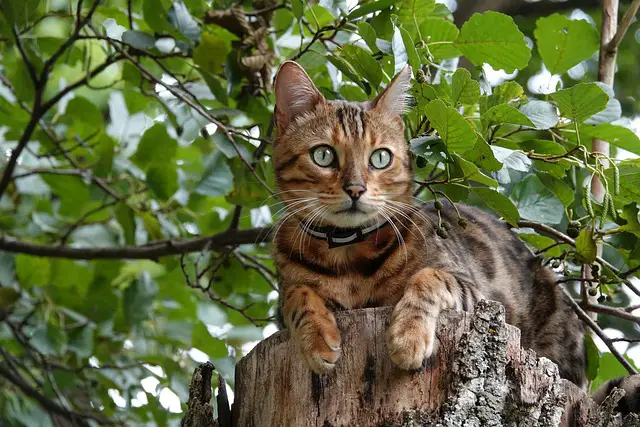There is a misconception that Bengal cats are inherently aggressive, but they are no more prone to aggression and behavioral problems than other domestic cat breeds.
When cats exhibit aggressive behavior, it is not the result of their breed – it is due to an external influence like inadvertent reinforcement, a health condition, prior experience, human influence, or boredom.
The Bengal Cat
The Bengal cat is an athletic domestic cat breed that resulted from breeding the Asian leopard cat with a domestic house cat (most commonly, the Egyptian Mau, Abyssinian, or American shorthair.)
Due to its mixed heritage, lovers of the breed do not consider the Bengal a pure breed cat but a hybrid, and due to its small size, the Bengal is also not classified as a “big cat,” but a domestic cat.
Is the Bengal a Wild Cat?
Since breeders have bred the Bengal cat from a wild cat, there is a mistaken belief that it retains the instincts of the Asian leopard cat. The fact is that breeders do not consider the Bengal cat to be a true Bengal unless it is four generations removed from the Asian leopard cat. This dilution of the ALC gene makes the Bengal more domestic than wild.
The Bengal Personality
The Bengal cat is a loving and affectionate breed that becomes very attached to its people. The Bengal is an athletic and loyal cat that is easier to train than many other feline breeds, and it even loves water!
Aggression and Cats
Cats can be aggressive for a variety of reasons that are nothing to do with breed and everything to do with other factors, including training, health, past experiences, and human influence.
Inadvertent Reinforcement
Bengal cats are very responsive to training, but sometimes owners can inadvertently reinforce less than desirable behavior. For example, if your cat mews repeatedly for attention and you respond by petting them, you are reinforcing that behavior, letting your cat know that if they mew, you will reward them with petting.
If the cat repeats this behavior in the future, but you do not respond by petting them, they can become aggressive as a bid to initiate the desired response.
It is also possible to inadvertently reinforce aggressive behavior and encourage your cat to repeat it. For example, if your cat acts aggressively because it is afraid and you respond by picking it up and showing it affection, you reinforce that behavior. So, the next time your cat wants you to pick it up, it may become aggressive.
Health
One of the most common reasons for aggression in animals is pain. Like humans, pain can set cats on edge, where even the lightest touch can initiate an aggressive response.
Numerous health conditions can cause a cat to become aggressive including:
- Arthritis.
- Infection.
- Dental disease.
- Hyperthyroidism.
- Degenerative joint disease.
- Neurological disorders.
- Degenerative joint disease.
If you suspect that your Bengal cat is exhibiting aggression due to a health concern, you must consult your veterinarian as soon as possible. If your cat is in pain, you must find out what is causing your cat’s pain and work with your vet to find pain relief that will improve your cat’s quality of life.
Past Experiences
Past experiences can also shape how cats respond to certain situations and one such response is aggression.
For example, if a snake bites your cat and your cat experiences a lot of pain due to that bite, the next time they see a snake, they may react aggressively. Any negative experience can cause this type of response.
To limit past experiences coloring future behavior, it helps to work on exposing your cat to any stimulus with which they have had a negative experience. Slow non-forceful exposure if the best way to do this, but if you are not confident in doing this, it is best to speak with a behavioral trainer who has more experience in behavioral conditioning.
Human Influence
Another common reason for aggression in cats is human influence. This type of aggression is common in households with younger children and novice cat owners.
Cats and humans have different behavioral patterns, body language, and habits. Often, we can do something innocuous in human interpretation but be threatening in feline body language.
If we make our cats feel threatened, it is hardly surprising that they react aggressively. In this situation, consulting a behavioral trainer can help. A trainer can help you learn more about your cat’s body language, vocal sounds, and other means of communication.
Boredom
Boredom is another frequent cause of aggression in cats – particularly high-energy breeds like the Bengal cat.
High energy cats must receive plentiful exercise to be happy and healthy. If you keep them cooped up with no means of releasing energy, Bengal cats will become bored, frustrated, and even aggressive at times.
You can avoid aggression due to boredom with the Bengal cat by ensuring that they have plenty of interactive toys, and exercise tools like the cat tree, obstacle course toys, and even remote-control toys! When you buy these toys, just be sure to buy toys that do not pose a choking risk.
Conclusion / Summary
Like any other cat, the Bengal cat can be aggressive, but this is usually the result of other factors like inadvertent reinforcement, a health condition, prior experience, human influence, or boredom – and not a characteristic of the Bengal breed in general.
[su_box title=”Affiliate Disclosure”]This website is supported by its readers. Please assume that all links are affiliate links. If you make a purchase from one of the links we will make a commission from Amazon. Thank you.[/su_box]




